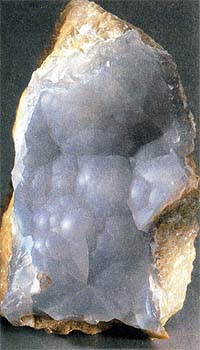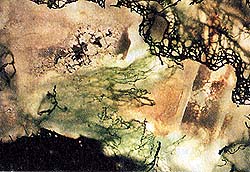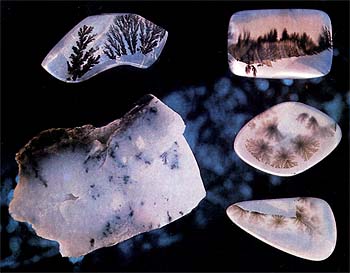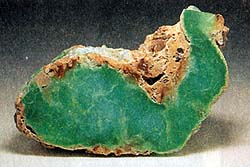Stone, minerals and semiprecious of the world stone
Oxide and hydrooxide: Chalcedony -->rus
 Diagnostic cart.
Diagnostic cart.
On a photo: Magnificent stone of concretionary blue chalcedony from Guttenberga (austrian a province Karintiya).
Si O2
Crystal structure trigonal
Hardness on the Mohs scale 7
Specific unit weight mass 2,6
Cleavage non-existent
Fracture, break padman
Colors colourless, multicolors
Colors in powder triturate white
Glance (glitter, glare) from glass to fat
Under chalcedony all of both group of cryptocrystalline minerals of silica (Agate, onyx, chrysoprase, carnelian, sard) is understood and actually Chalcedony, that him bluish (cyan) - or rather yellow-grey variety. Got the name Chalcedony on an ancient city in Asia Minor - Khalkedon. Unlike brilliant, as flowed, macrocrystalline minerals of group of quartz (such, as Quartz Rock Crystal, Amethyst and other), the waxen is inherent chalcedony, and on cleavage chip often dim brilliance.
Chalcedony a microcrystalline often greyish form of quartz with crystals arranged in parallel fibres: a gemstone. Formula: SiO2. Etymology: from Late Latin chalcedonius, from Greek khalkedon a precious stone (Revelation 21:19), perhaps named after Khalkedon Chalcedon, town in Asia Minor.
Chalcedony is an aggregate of shallow fibred crystals of silica, parallel each other. They are closely casebound with the particles of amorphous hydrate of silica and with grains of microcrystalline quartz. Microcrystalline, micromeritic of quartz is usually united in parallel strips or spherical aggregates. At a small thickness Chalcedony transparent; in other cases it is opaque. Glance (glitter, glare) glassy; mineral moderato hard and very durable. From point of the jeweller use it is designated the term of "Chalcedony" only stone with the weak colouring, suckling or opal color, light-grey, bluish (cyan) -grey or inconspicuous-brown. Colouring is up-diffused evenly or by the spots of different intensity.
Under a microscope evidently, that Chalcedony consists of the thinnest fibres, oriented athwart surfaces of excretions; macroscopically it is presented botryoidal, kidney-shaped reniform or by stalactitic-like excretions, in a cut - radially-radiant. The porous structure of mineral is stipulated by his ability easily sorb dye-stuffs. At natural chalcedony foliation, striation is not observed a simple eye, but in trading in chalcedonies sometimes name and Agates artificial synthetic ly painted in an inconspicuous-blue color.
Diagnostic indication.
At the moderate heating or simply protracted stay in the sunshine the color of some chalcedonies can change from rather yellow and brown to red and orange-red (as carnelian, iron).
Origin provenance genesis.
Chalcedony be found in emptinesses or cracks in igneous or basic sediments rocks. In them it is deposited as second mineral from the solutions saturated a silica, forming either layers or crusts or concretions or stalactites. On occasion Chalcedony appears as a result of substitution, including wood, bones, shells of shellfishes, corals, the silica of other matters.
Deposit minefield mine field occurrence subsoil.
Deposit of minefield mine field occurrence subsoil chalcedony widely widespread. Chalcedonys of Brazil, India, Madagascar and Uruguay is especially famous. In antiquity Chalcedony was a favourite stone for engraving, carving gems, considered that it guarded from mental disorder and melancholy. In our days this stone is used in a rock-cutting art for beads, cabochon. Among deposits antiquities are known Indian (there is Bombay in the state) and tuscan, developed as early as times of etruscans. Presently the basic varieties of chalcedony are obtained in Brazil and Uruguay. The two-bits of chalcedony are present in Italy.
Use, practical application, deployment.
From times of antiquity of Chalcedony mainly used for making of entail, seals, stamps, cameos. Now it is used foremost for the production of the articles of the decoratively-applied art: flatwares, small boxes, ash-trays etc. On jeweller business for chalcedony, cutting is mainly used cabochon. Varieties. Most notable varieties with the lamellar, streaky, striate colouring - Agate (white, reddish-brown and rather yellow) and black-white onyx. Among gauzy varieties, having the homogeneous colouring, the cornelian of orange-red (carnelian) is selected and more brownish (sard), chrysoprase, homogeneously apple-green and yellowish-green. Heliotrope is less known - dark-green with blood-redи spots and mossiness Agate-moss - light and opalescent, with including of threadlike minerals, reminding vegetable forms.
Varieties of chalcedony: Agate
From old times people used him for making of seals and amulets. Agate interesting distributing of colouring as the bent or concentric bars. Colors mainly dim - grey, yellow, brown, rarer greenish and blue. The main deposits of this semiprecious stone are found in Brazil and Uruguay. From Agate do beads and rings mainly; from varieties the strips of the rose and whitish colouring alternate in which, make intaglios and cameos. White agate - symbol of Spanish King (King is infallible impeccable).
Varieties of chalcedony: Agate mossiness (moss Agate, stone of Moses)
 It is more light and homogeneous, with the less expressed zonality, but differs the dendrites including of black-green and green color, reminding moss. Mossy Agate is translucent Chalcedony (from the scientific point of view it not Agate!) with the branching out threadlike, stem-like and featherlike cirrus including of amphibole or stratified silicates.
It is more light and homogeneous, with the less expressed zonality, but differs the dendrites including of black-green and green color, reminding moss. Mossy Agate is translucent Chalcedony (from the scientific point of view it not Agate!) with the branching out threadlike, stem-like and featherlike cirrus including of amphibole or stratified silicates.
In a ground stone their accumulations remind moss (from where and the name). If including is very much, a rock is named "mossy (moss) jasper" (that from the scientific point of view unright).
In nature mossy Agate (stone of Moses Jew, Hebrew) be found as streaks, executing cracks mainly in volcanic rocks; also in mineral deposits as pebble. The best in quality mossiness mushrooms act from India. Among other suppliers it is possible to mark China and USA (state of Colorado, Michigan, Oregon, Utah, Washington, Wyoming). Wonderful mossy Agates meet also in the CIS (Transcaucasia) and in Bulgaria (EU). Symbol of water danger for Jewries (Hebrew, Tora), as there are not mossy bogs in Israel (Middle East), jewries can drown in a bog on ignorance (a country of moss bogs is Belarus, CIS).
The pleasant red-brown colouring can appear as a result of infiltration of oxides of iron. Presently plenties of this mineral act from Brazil and India. A mossiness Agate-mossiness can be processed as little plates, cabochon, spheres for necklaces and necklace or pendants and brooches. Mossy Agates process usually as thin lamellar tabular insertions, exposing their pattern, or cabochon. Apply as insertions in brooches, coulombs, ear-rings and finger-rings. It very popular stone.
Varieties of chalcedony: Dendr-agate (dendrites, arboreal Agate)
 Dendr-agate is named colourless or bluish (cyan) -grey and milky-white translucent Chalcedonys (from the scientific point of view it not Agates, namely Chalcedonys !!) with treelike or ferny ingrown dendrites, formed hydroxide and oxides of manganese and iron. Dendrites have usually brown or black color. To the organic world, in spite of external likeness with plants ("dendrite" - in Greece treelike), they have no relation. Probably they can be likened to the frosty patterns on a window-pane.
Dendr-agate is named colourless or bluish (cyan) -grey and milky-white translucent Chalcedonys (from the scientific point of view it not Agates, namely Chalcedonys !!) with treelike or ferny ingrown dendrites, formed hydroxide and oxides of manganese and iron. Dendrites have usually brown or black color. To the organic world, in spite of external likeness with plants ("dendrite" - in Greece treelike), they have no relation. Probably they can be likened to the frosty patterns on a window-pane.
In similar forms rapid devitrify results on the walls of the thinnest cracks of solutions, taking away manganese and iron at weathering of containing rocks. In nature be found jointly with other varieties of chalcedony. The most known deposit of Dendr-Agate is in Brazil (state of Riu-grandi-du-sul); deposits are known also in India and USA. Because before Indian Dendr-Agates got to Europe through Yemen port of Mokka, they are named sometimes also Mokka -Agate.
Landscape, or landscape, Agate - it that Dendr-Agate. but more colourful, with comparatively expressly appearing landscape, where trees dendrites act part usually. Quite often can landscape appear and mossy Agates. Myukkenshteyn - Agate with "beauty-spot" is a variety of Dendr -Agate, in which shallow dendrites does not form a single pattern and remind the flattened midges. Symbol of the USA.
Sometimes arboreal Agate name the petrified tree, deputized a silica.
Varieties of chalcedony: Agate-carnelian and sard
The homogeneous orange-red colouring is most popular; sometimes, vice versa, a color has various tints. There is a variety in which not evidently the special including, except for the easy "curtain" of drops of liquid or lines of fracturing. More frequent than all luminesces white-blue luminescence which at carnelian from India substituted by greenish-yellowе. The most considerable deposits are in Brazil and Uruguay. More frequent used for treatment the cut in engraving (intaglios).
Carnelian and cornelian is a brownish-red and orange variety of Agate and chalcedony. Got the name on colouring, to reminding the color of berries of dogwood (lat. "cornix"), or, possibly, from lat. "corneus " - corporal. The most beautiful sorts of carnelian act from India: from the protracted stay on a bright sun light a brownish tint disappears and replaced thick orange-red tone. Greater part of carnelians, actings presently to the market - it tinted solution of nitrate of iron unattractive Agates from Uruguay or Brazil. In natural carnelians distributing of colouring is "cloudy", and in the ennobled agates - usually lamellar, streaky, striate.
Sarder is a russet and rather yellow variety of chalcedony, this term gradually goes out from the use. Adopted on a city Sardis in Asia Minor. Artificial synthetic painted sard get from grey chalcedony, saturating with him solution of the burnt sugar. Red carnelian is symbol a St. Valentine's Day (EU). No religion, no pontificate Vatican (is stone of the Ukraine, CIS).
A holiday of falling in love is in the countries of Western Europe (ES), marked on February, 14 every year. The in this day naive loving (more frequent than all, young people) is exchanged gifts or daryls each other red scarlet roses, but more frequent than all send an anonymous postal about a desire to have love (valentine), not specifying the name of sender here. In Western Europe (European Union, EU) it is fixed the first celebrate of the ruling and now well Spanish King (Merry King, there must be a recipient). Red carnelian is character of the forbidden sex and love forbidden in Western Europe. Substituted a red cinnabar from Almaden, Spain, EU (Mediterranean sea), red chalcedony carnelian brought death of the Roksolana in Asia (Turkey), in a moslem country.
 Varieties of chalcedony: Chrysoprase
Varieties of chalcedony: Chrysoprase
It is the most popular and valuable variety of chalcedony from the apple-green colouring and no-transparent. Colouring it is under an obligation the presence of the shallow including of nickeliferous minerals.
The colour style is not too steady, because grow pale at heating or protracted display in the sunshine. For renewal of color it is needed to hold for some the time харизопраз in a moist environment.
There is a chrysoprase mainly from Australia, from Ural, from California and Brazil. Used for making of oval plates with the cut in engraving (intaglios), brooches, pendants or spheres for a necklace and bangles. Precious and dearest variety of chalcedony, which can be mounted in silver and gold.
The greek name of chrysoprase, meaning literally "golden-onion", seems not fully clear today. Under a microscope the radially-radiant or subparallel location of fibres of silica is revealed. Colouring is conditioned adsorption and thin admixture of compounds of nickel. Large pieces of untilled chrysoprase often fracturing and unevenly painted. Colouring can fade in the bright sunshine or at the careless heating (requires exactness at soldering of wares). Refreshing the color of stone is possible, placing him for a time in a moist environment (for example, in a wet rag or earth).
Deposit of minefield mine field occurrence subsoil chrysoprase is timed to the barks of weathering of nickeliferous ultrabasic rocks, where it executes cracks and forms tumours. Chrysoprase comparatively rare. Before the most considerable was consider the deposit of Zombkovice in Overhead Silesia (Poland), developed from XIV century With 1960 Chrysoprase of the best quality act from Queensland, Australia. Their deposits are known also in Brazil, India, Republic of South Africa, on Madagascar, in the CIS (Ural, Kazakhstan) and USA (state is Arizona, California and Oregon).
Used as material for cabochon, cameos and shallow the plastic arts. The best sorts of chrysoprase quite often are processed the Frideswide cutting: a flat table is framed on an edge one in a number of shallow fasings (cutting got naming after Prussian king Frederic II). In XIX century a chrysoprase was used also for finishing of interiors (choir of св. Vaclav in Prague, palace of San-susi in Potsdame). Entangling a chrysoprase is possible with variscite, jade, Prehnite, smithsonite, zinc spar, and also with the artificial synthetic ly painted chalcedony.
Chrysoprase a matrix is name a chrysoprase with the white, rose or brown including of containing rocks. They are also used on rock-cutting business and polished as cabochon. Green chrysoprase - one of stone of Prophet of Mohammed (Mahomet moslems, islam, Asia). Along with a green beryl by an emerald, olivinom, demantoidom, malachite and other green stone, serves as character of green oases and green vegetation in the desert. Sacred stone of moslems. Sign of happiness and character of water - slightly moistened, becomes more green and some time has more dark colouring. If very dryly, a green chrysoprase in a decoration or skim of mineral slightly svetleet is a death-trap in the desert (sign). A promoter talisman, charm of writers and poets (is islam Koran).
